INTRODUCTION
There is no doubt that a cost effective way to become an owner of Elevating Work Platforms is to buy them second hand provided the EWP meets the regulations and conforms to Australian Standards. Otherwise the price of the EWP may be high no matter what you pay for it. Buying second hand equipment is especially valid for small rental fleet owners and end users. The world market for pre- owned EWPs has expanded rapidly over the past ten years as the major rental fleet owners continue their policies of removing rental units after 4-7 years of use and replacing with new.
POTENTIAL BUYERS
Elevating Work Platforms, by the very nature of the product and working conditions are a potentially high-risk product to own. Before “buying a bargain” it is essential to check out the basics to satisfy yourself as to the state of the EWP being considered and the level of risk you are prepared to take on.
LEGISLATION
Australia maintains a high safety standard and history when it comes to EWPs, helped by manufacturers, rental fleet owners, owners and end users working together with the relevant statutory bodies to ensure standards are maintained.
Key legislation currently in place includes:
- Occupational Health and Safety Acts
- Plant Regulations and Codes of Practice
- AS1418.10, AS2550.10, Australian Standards covering the design, testing and operationalrequirements of EWPs.
The OH&S Acts put the emphasis on all involved with EWPs on the “Duty of Care” requirement. This means that a supplier of EWPs must ensure the unit meets legal, safety and operational standards. Also employers have to ensure all operators have been adequately trained in the safe use and operation of the EWP.
This legislation follows on to the relevant Australian Standards, particularly AS1418 and AS2550. Conformance to these Codes will be seen as meeting ‘Duty of Care” requirements.
The key points from the legislation and Codes of Practice in regards to pre-owned EWPs include:
Annual Inspections
Major Inspections, i.e. Ten Year Test (thereafter every 5 years) Maintenance history/Manuals
Log Books
Operating Instructions
The Ten Year Test is particularly relevant when buying Pre-owned EWPs. AS2550.10 clearly states that an EWP must be Ten Year Tested in accordance with the standard which, in practice requires the EWP to be stripped down, and all relevant structural welds x-rayed.
For example on a 60’ (18.2m) Boom Lift this can mean an additional outlay of $25000 to $40000 depending on machine type, age, history and location. Then it all has to be repeated five years later!!
Meeting AS1418 is law in Australia and meeting AS2550 is in the process of being incorporated into legislation in most States. Where not specifically included in regulations all OH&S Authorities regard adherence to the Standards as a minimum requirement.
WHAT TO CHECK FOR IN ASSESSING AN EWP
- Check the Compliance Plate matches what it is advertised. eg. platform height, date of manufacture, model type, serial number.
- Check the EWPs maintenance history including retrofits, safety upgrades etc.
- Check the operational instructions are available and Decals in place and legible.
- Check the Ten Year Test requirement – if completed sight the Major Inspection Checklist that willconfirm who did the testing in Australia and their qualifications. Also check who carried out the non- destructive tests in Australia and if they meet the requirements of AINDT (Australian Institute of Non Destructive Testing).
- Check warranty claims and ease of obtaining spare parts and professional advice.
OTHER CONSIDERATIONS
- Check who the manufacturer is and if they are represented in Australia.
- Contact the manufacturer and seek their advice on the EWP you are interested in. Also ensure it iscovered by their product liability and what safety retrofits have been required on the unit.
- Contact the previous owner (details in Logbook) and confirm its working history.
- Work out what type of EWP you require with regards to working height, frequency of usage,reliability, ground conditions etc.
- If you have any doubts about what legislation is applicable in the State of operation phone therelevant WorkCover Authority and ask their advice.
FINALLY
Always “gather the facts” when considering purchasing an EWP be it new or pre-owned. Assistance is only a phone call away be it the manufacturer, a rental company, an owner, a user or the EWPAA.
Legislation can be particularly onerous and it is important to be pre-warned. (Eg, no pre-owned US market EWPs are sold into Europe, as they do not conform to the EC Standards). Like wise AS1418.10 is regarded as a more rigorous Standard than the US.
If still unsure ask yourself this key question:
“If there is an accident will I be blamed?”
This should help you focus on the “Duty of Care” aspects of the problem!!
